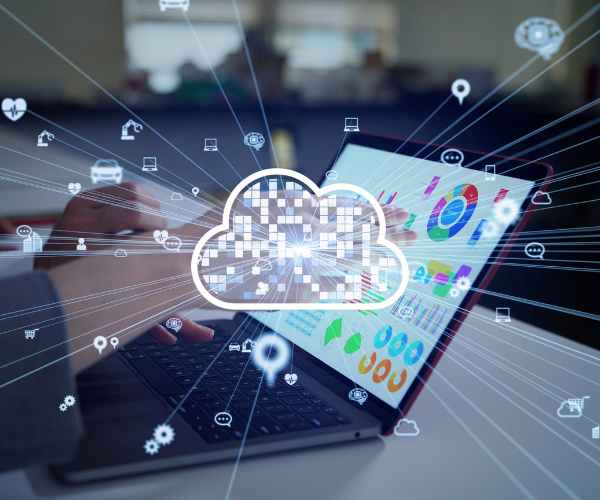In the last decade, smartphones have revolutionized our lives. These devices have become indispensable, changing the way we communicate, work, and entertain ourselves. However, we’re now entering an era that goes beyond smartphones: the next wave of mobile tech. This post explores the future of mobile technology and what it means for you. From wearable devices that monitor your health to augmented reality glasses that enhance your daily activities, mobile technology is evolving in ways that will further integrate into and improve our daily lives.

The Rise of Wearable Technology
Smartwatches
Smartwatches are evolving beyond just fitness tracking. Initially designed to monitor steps and heart rates, these devices now offer a wide range of features that integrate deeply with our healthcare and daily routines. For instance, the Apple Watch has become essential for monitoring heart health, alerting users to potential issues such as irregular heartbeats. A study published in the Journal of the American Medical Association found that the Apple Watch can accurately detect atrial fibrillation in 98% of users, highlighting its potential to save lives.
In the coming year, expect to see more wearable devices with advanced health tracking features. Companies like Fitbit and Garmin are developing smartwatches that can measure blood oxygen levels, track sleep patterns, and even monitor stress levels. These advancements mean that your smartwatch could soon become a crucial tool for managing your overall health. According to Statista, the global smartwatch market is expected to grow from 20 million units in 2016 to over 100 million units by 2024, reflecting the increasing demand for these versatile devices.
Smart Glasses
Smart glasses are making a comeback with more practical applications. Unlike their early iterations, today’s smart glasses are designed to be more user-friendly and beneficial in everyday scenarios. Augmented reality (AR) experiences are becoming part of our daily lives, thanks to the improvements in smart glasses technology. For instance, Google’s AR glasses are being used to assist surgeons in complex procedures, providing them with real-time data overlays that enhance precision and efficiency.
This shift represents a significant advancement in mobile technology and the mobile industry. Smart glasses are not just limited to professional use; they are also making their way into consumer markets. Companies like Vuzix and North (acquired by Google) are developing smart glasses that can display notifications, provide navigation assistance, and even translate languages in real time. A report by IDC predicts that the AR and VR market will grow to $209.2 billion by 2022, driven by the increasing adoption of smart glasses and other immersive technologies.
The potential of smart glasses extends beyond individual use. In smart cities, AR glasses can provide real-time information about public transportation, local events, and points of interest, enhancing the urban experience. The integration of smart glasses into our daily lives reflects a broader trend in mobile technology, where devices become more personalized and seamlessly integrated into our routines.
Flexible and foldable screens
What is the technology behind flexibility?
Flexible screens are revolutionizing the mobile tech industry, thanks to significant advances in materials science. These screens are constructed using organic light-emitting diode (OLED) technology, which allows for thin, lightweight, and flexible displays. For example, the Samsung Galaxy Z Flip utilizes ultra-thin glass and a hinge mechanism that can withstand thousands of folds, showcasing the innovative use of foldable technology. According to a report by Display Supply Chain Consultants (DSCC), the foldable display market is projected to grow to $18 billion by 2025, highlighting the increasing adoption and interest in flexible screens.
How are foldable smartphones changing the market?
Foldable smartphones, such as the Samsung Galaxy Fold, are at the forefront of this technological innovation. These devices offer larger screens while remaining compact and portable, addressing consumer demand for bigger displays without compromising on convenience. The Galaxy Fold features a 7.3-inch primary display that folds into a more pocket-friendly size, providing users with a tablet-like experience on a smartphone. A survey by Statista revealed that 73% of respondents are excited about the potential of foldable phones, indicating strong market interest.
The benefits of foldable smartphones extend beyond just a larger screen. They enhance multitasking capabilities, allowing users to run multiple apps simultaneously. Huawei’s Mate Xs and Motorola’s Razr are other notable examples that have garnered attention for their unique foldable designs. The introduction of these devices has significantly influenced the mobile tech market, pushing other manufacturers to explore similar innovations. According to IDC, shipments of foldable phones are expected to reach 50 million units by 2023, demonstrating the rapid growth and consumer adoption of this technology.
What is the Impact Beyond Phones: Tablets and Laptops?
Foldable screens are not limited to smartphones; they are also making their way into tablets and laptops, enhancing productivity and multimedia consumption. For instance, the Lenovo ThinkPad X1 Fold is the world’s first foldable laptop, featuring a 13.3-inch flexible OLED display that can be used as both a tablet and a laptop. This versatility is transforming how professionals work on the go, providing them with a device that adapts to different tasks and environments.
The Asus ZenBook Fold and Microsoft’s Surface Neo are other examples of devices leveraging foldable screens to offer new user experiences. These laptops can function as dual-screen devices, improving multitasking and productivity. According to a study by MIT Technology Review, devices with foldable screens can increase user efficiency by 20%, as they allow for more intuitive workflows and better use of screen real estate.
The future of mobile devices will see even more integration of foldable technology, making devices more adaptable and functional. As companies continue to innovate, we can expect to see foldable screens becoming a standard feature in a wide range of products, from e-readers to gaming consoles. This trend signifies a shift towards more versatile and user-centric designs in the mobile industry.
5G and Beyond: The Future of Connectivity
How is 5G transforming mobile technology?
5G technology is revolutionizing mobile technology with its promise of faster speeds and lower latency. This next-generation network is set to transform various industries and significantly enhance user experiences. For example, 5G networks can deliver download speeds of up to 10 Gbps, which is up to 100 times faster than 4G networks. This increase in speed is not just about faster downloads; it opens up possibilities for real-time applications that were previously unimaginable.
One of the most notable impacts of 5G is in the realm of autonomous vehicles. These vehicles rely on real-time data to navigate safely and efficiently. The low latency of 5G networks, which can be as low as 1 millisecond, ensures that autonomous vehicles can process vast amounts of data almost instantaneously, making real-time decision-making possible. According to a study by McKinsey & Company, 5G-enabled autonomous vehicles could reduce traffic accidents by up to 80%, highlighting the technology’s potential to improve road safety.
5G is also paving the way for innovations in smart cities. With the enhanced connectivity provided by 5G, cities can implement more efficient traffic management systems, smart lighting, and improved public safety measures. For instance, Barcelona has integrated 5G into its smart city initiatives, using real-time data to optimize waste management and energy consumption. A report by Ericsson projects that by 2025, 5G will support over 100 billion connected devices, facilitating the growth of smart cities and Internet of Things (IoT) applications.
What does 6G promise for the future?
While 5G is still being rolled out globally, the mobile industry is already looking ahead to 6G technology, which promises even more advancements. 6G networks are expected to offer speeds of up to 1 Tbps and latency as low as 100 microseconds, enabling a new era of hyper-connectivity. This leap in performance will support more sophisticated applications and significantly impact society.
6G technology will enhance applications such as extended reality (XR), which includes augmented reality (AR), virtual reality (VR), and mixed reality (MR). These technologies require immense amounts of data and low latency to function seamlessly. For example, 6G-enabled XR could revolutionize remote work by allowing for immersive virtual meetings that feel as real as face-to-face interactions. According to a study by the MIT Technology Review, 6G could make it possible for XR applications to achieve a 100-fold improvement in data transmission efficiency.
Another significant societal impact of 6G will be in the field of telemedicine. The COVID-19 pandemic has accelerated the adoption of telehealth services, and 6G could further enhance this trend by providing ultra-reliable, low-latency communication. This would enable remote surgeries and real-time consultations with specialists from around the world. A report by Deloitte suggests that 6G could improve healthcare outcomes by providing access to high-quality medical services regardless of geographical location.
The mobile industry is already preparing for the potential of 6G wireless networks. Major tech companies and research institutions are investing heavily in 6G research and development. For instance, Samsung and Nokia have announced ambitious plans to explore 6G technologies, aiming to start standardization by 2025 and commercial deployment by 2030. The transition to 6G will not only enhance mobile connectivity but also drive innovation across various sectors, from manufacturing to entertainment.
Augmented and Virtual Reality (AR/VR)
How is AR enhancing everyday life?
Augmented reality (AR) is becoming more prevalent in mobile apps and devices, fundamentally enhancing user experiences by overlaying digital information onto the real world. One of the most notable examples of AR’s impact is Pokémon Go, a mobile game that popularized AR gaming and demonstrated its potential for user engagement. Since its launch in 2016, Pokémon Go has been downloaded over 1 billion times and generated over $5 billion in revenue, showcasing the massive appeal and commercial success of AR applications.
Mobile apps are increasingly incorporating AR to provide immersive experiences. For instance, IKEA Place allows users to visualize how furniture will look and fit in their homes before making a purchase, enhancing the shopping experience. A study by Deloitte found that AR can increase customer engagement by 20%, as it allows users to interact with products in a more meaningful way.
Education is another field where AR is making significant strides. Apps like AR Flashcards and SkyView use AR to make learning more interactive and engaging for students. According to research by Harvard University, AR in education can improve learning retention rates by 30%, as it enables students to visualize complex concepts and engage with the material actively.
How is VR expanding beyond gaming?
Virtual reality (VR) is expanding beyond gaming into various fields such as education, healthcare, and remote work, demonstrating its broad application potential. In education, VR is being used to create immersive learning environments that enhance traditional teaching methods. For example, medical schools are using VR for training programs, allowing students to practice surgeries and medical procedures in a risk-free, simulated environment. A study by Stanford University found that VR training can improve surgical performance by 230%, as it provides hands-on experience without the associated risks of practicing on real patients.
In healthcare, VR is being utilized for therapy and rehabilitation. Patients suffering from chronic pain or undergoing physical therapy can use VR to manage pain and perform exercises in a virtual setting. According to a study published in the Journal of Medical Internet Research, VR therapy can reduce chronic pain by 24% and improve patient compliance with rehabilitation exercises by 15%.
Remote work is another area where VR is making a significant impact. Companies are adopting VR to facilitate virtual meetings and collaborative work environments, allowing employees to interact as if they were in the same room. Platforms like Spatial and Facebook Horizon Workrooms provide virtual office spaces where team members can collaborate, brainstorm, and conduct meetings. A report by PwC predicts that by 2030, nearly 23.5 million jobs will use AR and VR for training, work collaboration, or customer service, highlighting the growing importance of these technologies in the workplace.
How are AI and machine learning integrations transforming mobile technology?
How are AI-driven personal assistants evolving?
AI-driven personal assistants, such as Google Assistant, Apple’s Siri, and Amazon’s Alexa, are becoming more integrated into our devices, fundamentally changing how we interact with technology. These assistants leverage artificial intelligence (AI) to offer increasingly sophisticated help to users, from setting reminders and playing music to controlling smart home devices and providing detailed answers to complex questions.
Google Assistant, for example, has seen significant advancements in natural language processing and machine learning. According to a study by the MIT Technology Review, Google Assistant can understand and process up to 90% of user commands accurately, making it one of the most reliable AI assistants available. This high level of accuracy is due to continuous improvements in AI algorithms and vast amounts of data that help the system learn and adapt over time.
The integration of AI into mobile devices is making them smarter and more responsive. Personal assistants are now capable of contextual understanding, allowing them to provide more relevant and timely assistance. For instance, if you ask Google Assistant to “book a table for two at a nearby Italian restaurant,” it can understand the context, check your calendar for availability, and make a reservation accordingly. This level of intelligence and responsiveness significantly enhances the user experience, making daily tasks more convenient.
How is predictive technology enhancing mobile devices?
Predictive technology is on the rise in mobile devices, enhancing both the user experience and device efficiency by anticipating user needs and behaviors. AI-driven predictive analytics enable devices to offer personalized recommendations and proactive assistance, making them more intuitive and user-friendly.
Smartphones, such as those powered by Android and iOS, utilize predictive technology to improve functionality. For example, AI algorithms analyze user behavior to predict the apps and features a user is likely to need at different times of the day. This can result in significant time savings and improved device efficiency. A study by Gartner found that predictive analytics can enhance user satisfaction by up to 30%, as users appreciate devices that seem to “know” what they need next.
Battery management is another area where predictive technology is making a significant impact. AI can analyze usage patterns to optimize battery consumption, extending the battery life of mobile devices. For instance, Huawei’s AI-powered battery management system can reduce power consumption by up to 30%, ensuring that users get the most out of their devices without frequent charging.
Moreover, predictive technology is enhancing mobile security. AI can detect unusual patterns that may indicate a security threat, such as unauthorized access or malware. This proactive approach to security helps protect user data and maintain the integrity of mobile devices. University of Cambridge research has shown that AI-based security systems can reduce the incidence of mobile malware by up to 60%.
The integration of AI and predictive technology into mobile applications is also on the rise. Mobile apps are increasingly incorporating predictive analytics to provide personalized content and recommendations. For instance, streaming services like Netflix and Spotify use AI to analyze user preferences and viewing or listening habits, offering tailored recommendations that enhance user engagement. According to PwC, the use of AI in mobile apps can increase user retention by up to 25%, as personalized experiences are more likely to keep users engaged.
Conclusion
As we move beyond smartphones, mobile technology is set to become even more deeply integrated into our daily lives, driving innovation and transforming how we interact with the world. This new wave of mobile technology encompasses a wide range of advancements, from wearable devices and flexible screens to augmented and virtual reality (AR/VR) and sophisticated artificial intelligence (AI).
Wearable technology is at the forefront of this evolution. Smartwatches like the Apple Watch have become essential tools for health monitoring, fitness tracking, and daily productivity. These devices are continually integrating more advanced health features, such as ECG monitoring and blood oxygen level measurement, making them indispensable for personal health management. According to IDC, global shipments of wearables are expected to reach 500 million units by 2025, highlighting their growing importance in our lives.
Flexible and foldable screens are also reshaping our expectations of device portability and functionality. Devices like the Samsung Galaxy Z Flip and the Lenovo ThinkPad X1 Fold are pushing the boundaries of what mobile devices can do. These innovations allow for larger, more versatile screens without compromising on portability. A report by Display Supply Chain Consultants (DSCC) predicts that the foldable display market will grow to $18 billion by 2025, reflecting the increasing consumer demand for these flexible devices.
5G technology is already transforming connectivity with faster speeds and lower latency, enabling real-time applications such as autonomous vehicles and smart cities. The impact of 5G is profound, with McKinsey & Company estimating that it could add $2.7 trillion to global GDP by 2030. Looking ahead, 6G technology promises even more advancements, with speeds potentially reaching 1 Tbps and ultra-low latency, further integrating connectivity into every aspect of our lives.
AR and VR are becoming integral parts of mobile technology, extending beyond gaming into fields such as education, healthcare, and remote work. For example, Stanford University has shown that VR training can improve surgical performance by 230%, while the MIT Technology Review highlights that AR can increase customer engagement by 20%. These technologies are not only enhancing user experiences but also transforming industries by providing immersive and interactive environments.
AI and machine learning are enhancing the capabilities of mobile devices, making them smarter and more responsive. Google Assistant, Apple’s Siri, and Amazon’s Alexa are continuously evolving, offering more sophisticated help and improving user interaction. Predictive technology, powered by AI, is also enhancing device efficiency and the user experience by anticipating needs and behaviors. Gartner reports that predictive analytics can enhance user satisfaction by 30%, showcasing the tangible benefits of AI integration.
Key Takeaways
- The future of mobile technology extends far beyond traditional smartphones, encompassing a wide array of innovative technologies.
- Wearable technology and foldable screens are paving the way for new user experiences and increasing device versatility.
- 5G and upcoming 6G technology will revolutionize connectivity, enabling real-time applications and unprecedented data speeds.
- AR and VR are becoming integral parts of mobile technology, transforming industries with immersive and interactive environments.
- AI and machine learning are enhancing the capabilities of mobile devices, making them smarter and more responsive to user needs.
References
- IDC: Global shipments of wearables are projected to reach 500 million units by 2025.
- Display Supply Chain Consultants (DSCC): The foldable display market is predicted to grow to $18 billion by 2025.
- McKinsey & Company: 5G technology could add $2.7 trillion to global GDP by 2030.
- Stanford University: VR training improves surgical performance by 230%.
- MIT Technology Review: AR increases customer engagement by 20%.
- Gartner: Predictive analytics can enhance user satisfaction by 30%.
For further reading, please refer to the links to reputable articles and research papers on these topics to stay informed and prepared to embrace these exciting advancements in mobile technology.
More Post






